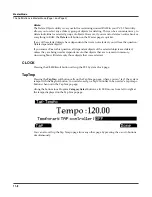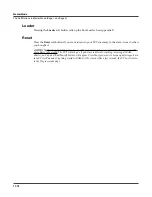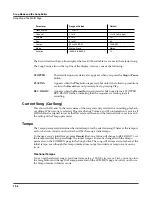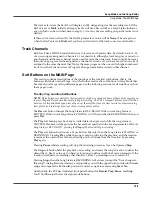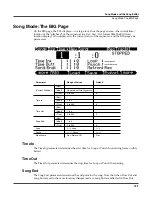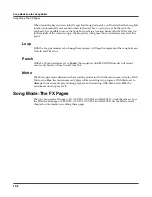
Master Mode
Master Mode Page 2
11-5
Scroll through the list of Intonation tables, and listen for the differences between semitones.
Some of the intervals between semitones may be quite different from equal intonation, but
you’ll notice that all notes are precisely tuned with notes that are an octave apart. This is because
the intonation tables set the intervals within a single octave, and apply those intervals to each
octave.
List and Description of Intonation Tables
In general, you should select a nonstandard intonation table when you’re playing simple
melodies (as opposed to chords) in a particular musical style. When you use intonation tables
based on pentatonic scales, you’ll normally play pentatonic scales to most accurately reproduce
those styles.
Key Action Map
The Key Action Map determines the way the PC3 respond to key action. Different maps result in
different responses from the PC3 for the same physical key action.
Generally speaking, you will not want to alter the Key Action Map. If you do, however, and
want to change it back to the default map, simply enter a values of
0
in the Key Action Map
parameter field.
Default Sequence
The Default Sequence parameter specifies the song that is used as a template for new and clear
songs in Song mode.
1 Equal
No detuning of any intervals. The standard for modern western music.
2 Classic Just
Tunings are defined based on the ratios of the frequencies between intervals.
The original tuning of Classical European music.
3 Just Flat 7th
Similar to classic Just, but with the Dominant 7th flatted an additional 15 cents.
4 Harmonic
The perfect 4th, Tritone, and Dominant 7th are heavily flatted.
5 Just Harmonic
6 Werkmeister
Named for its inventor, Andreas Werkmeister. It’s fairly close to equal
temperament, and was developed to enable transposition with less dissonance.
7 1/5th Comma
8 1/4th Comma
9 Indian Raga
Based on the tunings for traditional Indian music.
10 Arabic
Oriented toward the tunings of Mid-Eastern music.
11 BaliJava1
Based on the pentatonic scale of Balinese and Javanese music.
12 BaliJava2
A variation on 1Bali/Java, slightly more subtle overall.
13 BaliJava3
A more extreme variation.
14 Tibetan
Based on the Chinese pentatonic scale.
15 CarlosAlpha
Developed by Wendy Carlos, an innovator in microtonal tunings, this intonation
table flats each interval increasingly, resulting in an octave with quarter-tone
intervals.
16 Pyth/aug4
This is a Pythagorean tuning, based on the Greek pentatonic scale. The tritone
is 12 cents sharp.
17 Pyth/dim5
This is a Pythagorean tuning, based on the Greek pentatonic scale. The tritone
is 12 cents flat.
Summary of Contents for PC3
Page 24: ...1 6 Introduction Options ...
Page 50: ...4 4 The Operating Modes Using the Modes ...
Page 174: ...7 54 Setup Mode The Utility Soft Buttons ...
Page 178: ...8 4 Quick Access Mode Making Your Own QA Banks ...
Page 204: ...9 26 Effects Mono Algorithms ...
Page 266: ...A 2 MIDI Implementation Chart ...
Page 308: ...Index x ...


















